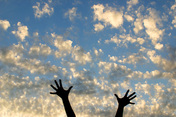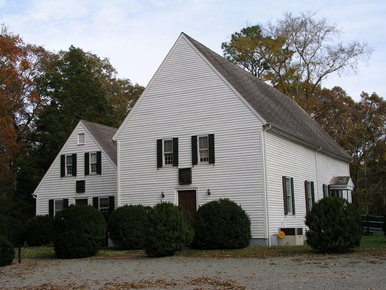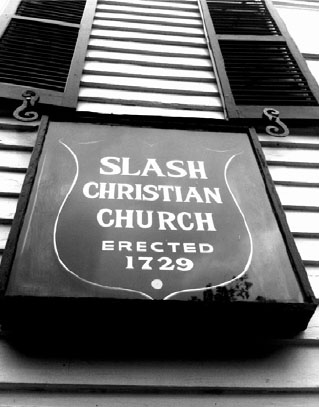Slash Christian Church
Slash has been reaching up to a loving God for a long time.
Our sanctuary was built three years before George Washington was born. We have a long history and are proud to share it with visitors. Our historian would love to give a tour to you or your group. Email her by following the link for scheduling information. Read the History of Slash Church below or download a copy. If you are searching for Burial Records, you may download ours and look for one of your ancestors. |
The History of Slash Church, St. Paul’s Parish, Hanover County
The Oldest Frame Colonial Church in Continuous Use in Virginia.

The Establishment of Slash Church
Slash Church is located in Hanover County, which was formed in 1720 by the colonial government of Virginia in Williamsburg. The people living around what would become the Slash Church property were assigned to the St. Paul’s Parish. A parish was an administrative district that the Church of England used to conduct the business of both church law and English law. Landowners answered to the Rectors (Pastors) of the parish and to the Vestry, which they elected. These authorities also acted as a branch of the Colonial Government. The Vestry appointed Church Wardens who collected taxes and held court in parish churches. Money and records were forwarded to Williamsburg. Each landowner was required by law to attend church so a legal head count could be maintained for tax purposes.
The Vestry of St. Paul's Parish convened June 16, 1729 and authorized the purchase of three acres from the southeast corner of Mr. William Alsop, Jr.’s farm. Just one month later, on July 17, 1729, the Vestry reconvened and approved the construction of a large Upper Church. This location was selected because it occupied a nice hill with a number of trees and included a spring with a bountiful water supply. The numerous ravines, or slashes, gave Slash Church its name. The building, constructed of Southern Yellow Pine cut from the property, was also mortised with wooden pegs.
The Early Years of Slash Church
The first rector of Slash Church was the Reverend Zachary Brook, who had previously served Mechumps Creek Church. He served Slash until 1737, when Rev. Patrick Henry (uncle of the famous orator) was called. The first governor of Virginia, Patrick Henry, First Lady Dolley Payne Madison, and Statesman Henry Clay are all believed to have worshipped at Slash Church on occasion during their formative years growing up in Hanover County. The late 1700s were a time of religious and governmental upheaval and after Rev. Henry’s death in 1777, Slash became a free for use church. Newly formed religious dissenters used Slash for their worship services and during the week the building was used as a school. Although other protestant denominations also used Slash for several years, the Methodists and the Disciples of Christ emerged as the principal users. In 1842, the Disciples purchased the Slash property and the Methodists acquired nearby land, where they built Lebanon Methodist Episcopal Church.
Slash Church and the Civil War
On May 26 & 27, 1862, amidst the Civil War, Slash Church became the headquarters for Confederate Brig. Gen. L. OB Branch and the 4500 troops under his command. Two battles in the vicinity on May 27 resulted in a victory for the Union forces. Several local homes and Slash Church were used as hospitals for the more than 300 wounded. This encounter was called the Battle of Slash Church in the South and the Battle of Hanover Courthouse in the North. Trees cut down on the property around the 1950s contained bullets from these battles.
Additions to Slash Church
In the years after the war, Slash continued to grow and meet regularly as a Disciples of Christ church. The building may have been used as a public school during the week as well as for hosting the many social events of the congregation. In 1953 Lena Stafford Williams, church historian, undertook an ambitious restoration project to return the interior of the sanctuary to its original appearance, insofar as could be ascertained. Among the many changes, nineteenth century furniture was replaced with replicas, a center aisle replaced the double aisles and the exterior locks were replaced with reproductions of those used in the 1700s. Through the years, congregations have repeatedly raised money to scrape, paint and repair the original clapboard siding and continued to maintain the historic simplicity in the sanctuary.
In 1955, Burley P. Loving donated and helped build an education building adjacent to the original church. It was dedicated in honor of his family and was designed to replicate the original building on a smaller scale. The rooms have been repurposed over the years, but initially they held Sunday School classrooms and a nursery.
On January 9, 1970, a furnace fire broke out in the hallway connecting the Slash Church sanctuary to the Loving Building and spread through the ducts. Thanks to a quick acting passerby, the damage to the sanctuary was limited to one wall, the floor, and a small part of the roof. After the fire, original lumber that had to be removed was reused as much as possible in the repairs to the north wall and beams. During the restoration process that spring, workers discovered that the flooring in the nave had succumbed to termites. Though the fire ruined many things, it exposed the termite damage allowing congregants to minimize the impact of the insects. In 1972 and 1977, two brick buildings were erected on the grounds. These two structures are connected and house additional educational classrooms, office space, a kitchen and a fellowship hall.
Slash Church to the Present
In 1988 the congregation began performing a re-enactment of the Christmas story called Why The Star. Originally it was a drive through presentation, but in 1996 sets for the various scenes were built and placed along a winding path through the surrounding woods. Now the story is performed every other year and draws hundreds of people each time. It features live animals and musical performances as the congregation reenacts the events that led up to the birth of Christ.
In 2019 a pavilion was built on the property behind the brick fellowship hall. It provides storage for picnic tables and other equipment as well as a covered area with a brick outdoor fireplace. This space was used for outdoor services during the Covid 19 pandemic in 2020, allowing the congregation to continue meeting in person, but more spread out.
In 2029, Slash Church will celebrate its 300th anniversary.
Historic Highway Marker
Slash Church is listed on both the Virginia and United States Historic Registers. A Historic Highway Marker was erected and dedicated at the intersection of Peaks Road and Mount Hermon Road on October 4, 1998. There is a small roadside, woodland park surrounding the marker and a turnout for off-road parking.
____________________
A more extensive written history is available on the link on this page and can also be found in the History Room of the Loving Building at Slash Church.
Tours of Slash Church are offered upon request. We ask that you call the church or email the historian to schedule an appointment so that we can arrange for an available guide. Tours last approximately 40 minutes. (804-798-4520 or historian@slashcc.org )
Slash Church is located in Hanover County, which was formed in 1720 by the colonial government of Virginia in Williamsburg. The people living around what would become the Slash Church property were assigned to the St. Paul’s Parish. A parish was an administrative district that the Church of England used to conduct the business of both church law and English law. Landowners answered to the Rectors (Pastors) of the parish and to the Vestry, which they elected. These authorities also acted as a branch of the Colonial Government. The Vestry appointed Church Wardens who collected taxes and held court in parish churches. Money and records were forwarded to Williamsburg. Each landowner was required by law to attend church so a legal head count could be maintained for tax purposes.
The Vestry of St. Paul's Parish convened June 16, 1729 and authorized the purchase of three acres from the southeast corner of Mr. William Alsop, Jr.’s farm. Just one month later, on July 17, 1729, the Vestry reconvened and approved the construction of a large Upper Church. This location was selected because it occupied a nice hill with a number of trees and included a spring with a bountiful water supply. The numerous ravines, or slashes, gave Slash Church its name. The building, constructed of Southern Yellow Pine cut from the property, was also mortised with wooden pegs.
The Early Years of Slash Church
The first rector of Slash Church was the Reverend Zachary Brook, who had previously served Mechumps Creek Church. He served Slash until 1737, when Rev. Patrick Henry (uncle of the famous orator) was called. The first governor of Virginia, Patrick Henry, First Lady Dolley Payne Madison, and Statesman Henry Clay are all believed to have worshipped at Slash Church on occasion during their formative years growing up in Hanover County. The late 1700s were a time of religious and governmental upheaval and after Rev. Henry’s death in 1777, Slash became a free for use church. Newly formed religious dissenters used Slash for their worship services and during the week the building was used as a school. Although other protestant denominations also used Slash for several years, the Methodists and the Disciples of Christ emerged as the principal users. In 1842, the Disciples purchased the Slash property and the Methodists acquired nearby land, where they built Lebanon Methodist Episcopal Church.
Slash Church and the Civil War
On May 26 & 27, 1862, amidst the Civil War, Slash Church became the headquarters for Confederate Brig. Gen. L. OB Branch and the 4500 troops under his command. Two battles in the vicinity on May 27 resulted in a victory for the Union forces. Several local homes and Slash Church were used as hospitals for the more than 300 wounded. This encounter was called the Battle of Slash Church in the South and the Battle of Hanover Courthouse in the North. Trees cut down on the property around the 1950s contained bullets from these battles.
Additions to Slash Church
In the years after the war, Slash continued to grow and meet regularly as a Disciples of Christ church. The building may have been used as a public school during the week as well as for hosting the many social events of the congregation. In 1953 Lena Stafford Williams, church historian, undertook an ambitious restoration project to return the interior of the sanctuary to its original appearance, insofar as could be ascertained. Among the many changes, nineteenth century furniture was replaced with replicas, a center aisle replaced the double aisles and the exterior locks were replaced with reproductions of those used in the 1700s. Through the years, congregations have repeatedly raised money to scrape, paint and repair the original clapboard siding and continued to maintain the historic simplicity in the sanctuary.
In 1955, Burley P. Loving donated and helped build an education building adjacent to the original church. It was dedicated in honor of his family and was designed to replicate the original building on a smaller scale. The rooms have been repurposed over the years, but initially they held Sunday School classrooms and a nursery.
On January 9, 1970, a furnace fire broke out in the hallway connecting the Slash Church sanctuary to the Loving Building and spread through the ducts. Thanks to a quick acting passerby, the damage to the sanctuary was limited to one wall, the floor, and a small part of the roof. After the fire, original lumber that had to be removed was reused as much as possible in the repairs to the north wall and beams. During the restoration process that spring, workers discovered that the flooring in the nave had succumbed to termites. Though the fire ruined many things, it exposed the termite damage allowing congregants to minimize the impact of the insects. In 1972 and 1977, two brick buildings were erected on the grounds. These two structures are connected and house additional educational classrooms, office space, a kitchen and a fellowship hall.
Slash Church to the Present
In 1988 the congregation began performing a re-enactment of the Christmas story called Why The Star. Originally it was a drive through presentation, but in 1996 sets for the various scenes were built and placed along a winding path through the surrounding woods. Now the story is performed every other year and draws hundreds of people each time. It features live animals and musical performances as the congregation reenacts the events that led up to the birth of Christ.
In 2019 a pavilion was built on the property behind the brick fellowship hall. It provides storage for picnic tables and other equipment as well as a covered area with a brick outdoor fireplace. This space was used for outdoor services during the Covid 19 pandemic in 2020, allowing the congregation to continue meeting in person, but more spread out.
In 2029, Slash Church will celebrate its 300th anniversary.
Historic Highway Marker
Slash Church is listed on both the Virginia and United States Historic Registers. A Historic Highway Marker was erected and dedicated at the intersection of Peaks Road and Mount Hermon Road on October 4, 1998. There is a small roadside, woodland park surrounding the marker and a turnout for off-road parking.
____________________
A more extensive written history is available on the link on this page and can also be found in the History Room of the Loving Building at Slash Church.
Tours of Slash Church are offered upon request. We ask that you call the church or email the historian to schedule an appointment so that we can arrange for an available guide. Tours last approximately 40 minutes. (804-798-4520 or historian@slashcc.org )
Location of Highway Marker
|
Erected at the intersection of northwest
corner of Peaks Road and southeast corner of Mount Hermon Road, Historic Highway Marker E 105
Department of Historic Resources Commonwealth of Virginia SLASH CHURCH Erected in 1729-32 as the Upper Church of Saint Paul's Parish, Hanover County, Slash Church's location next to swampy woods (a "slash" in 18th-century terms) gave it its name. The Reverend Patrick Henry, uncle of the famous patriot, served as rector from 1737 until 1777. Among its early worshipers the church claims Patrick Henry, Dolley Madison, and Henry Clay, all once residents of the area. During the Civil War, Slash Church was used as a hospital and gave a nearby cavalry battle its name. This white weatherboarded structure survives as the oldest and best-preserved frame colonial church in Virginia, and the only one to escape enlargement. July 1998 |
The Ministers of Slash Church Early Ministers - St. Paul' Parish
1701-1785 Rev. James Bowker Rev. Richard Squire Rev. James Breechin (or Breckin) Rev. Daniel Taylor Rev. John Monro Rev. Thomas Sharp - 1708/1720 Rev. Zachery (or Zachariah) Brook - 1721/1736 Rev. Joseph Blunfield - 2 months Rev. Patrick Henry - 1737/1777 Rev. William Dunlop - a few months of 1778, left and called again with new vestry Rev. Jesse Carter to 1785. Disciple Circuit Riders – Hanover Rev. C. B. Moore and Rev. Silas Shelburne Virginia Convention Delegates 1873 Mr. N. Waldrop and Mr. J. L. Dyson Ministers 1890 to Now
Rev. Z. Parker Richardson 1890's Rev. W. J. Hall 1910 Rev. W. S. Hoye 1913 - 10/1915 Rev. J. F. Moore 09/1916 - 09/1917 Rev. R. A. Atkins 10/1917 - 10/1926 Rev. Richard A. Fox 10/1926 - 02/1930 Rev. Alvin R. Reynolds 06/1930 - 08/1943 Rev. J. H. Knibb 09/1943 - 07/1947 Rev. George A. Williams, Jr. 10/1947 - 09/1955 Rev. Larry E. Whitley 09/1956 - 01/1958 Rev. Robert B. Johnson 06/1958 - 07/1961 Rev. Wm. F. Abernathy 08/1961 - 09/1962 Rev. William Whitehurst 06/1963 - 08/1967 Rev. L. Carlton Lyon 07/1968 - 10/1975 Rev. Carl G. France 02/1976 - 10/1980 Rev. Robert L. Bohannon 06/1981 - 06/1987 Rev. Richard Cline 02/1988 - 03/1995 Interim: Rev. Robert Maphis 04/ 1995 - 05/1996 Rev. Donald L. Richardson 06/1996 - 09/2004 Interim: Rev. Robert Maphis 10/2004 - 08/2005 Revs. Steve & Jyn Lesher 09/2005 - 09/2008 Interim Rev. Jim Burton 04/2009 - 12/2009 Rev. Michael Weeks 06/2010 - present |

